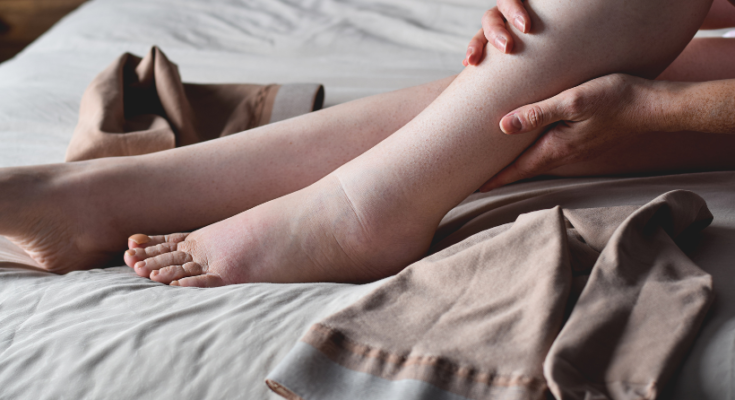Lymphedema Treatment: Lymphedema is a chronic condition characterized by the abnormal swelling of body parts, commonly affecting the arms or legs, due to a malfunction in the lymphatic system.
This condition arises when lymphatic fluid accumulates in the tissues due to disruptions in the normal lymph flow, leading to swelling, discomfort, and potential complications.
Understanding Lymphedema
Lymphedema is a chronic medical condition characterized by the swelling of parts of the body, typically the arms or legs, due to a build-up of lymph fluid. This occurs when the lymphatic system, which is crucial for immune function and fluid balance, is damaged or blocked. Understanding the types, statistics, and demographics affected by lymphedema can help in recognizing the importance of managing this condition effectively.
Types of Lymphedema
Lymphedema can be classified into two main types:
- Primary Lymphedema: This form is less common and is usually due to genetic factors that affect the development of lymph vessels in the body. It can occur at birth, during puberty, or in adulthood, but symptoms often appear in early adulthood.
- Secondary Lymphedema: More prevalent than primary lymphedema, secondary lymphedema develops as a result of damage to the lymphatic system. Common causes include surgery, radiation therapy for cancer, infection, or trauma that affects the lymph nodes or lymph vessels. Cancer treatments involving lymph node removal are a significant cause of secondary lymphedema.
Statistics and Demographics Affected
Lymphedema affects a substantial number of individuals worldwide, though exact figures can vary based on region and underlying causes. Here are some key statistics and demographic insights:
- Prevalence: Globally, it is estimated that up to 250 million people are affected by lymphedema or related disorders. In the United States, lymphedema affects approximately 10 million people, making it more prevalent than several well-known conditions combined, such as Parkinson’s disease, multiple sclerosis, muscular dystrophy, and AIDS.
- Risk Factors and Populations: Individuals who undergo cancer treatment, especially for breast, prostate, lymphoma, and melanoma cancers, are at a higher risk of developing secondary lymphedema. Women who undergo breast cancer surgery with lymph node removal are particularly susceptible.
- Age and Gender: While lymphedema can affect individuals of any age, certain types of primary lymphedema are more likely to manifest at specific stages of life, such as during puberty. Secondary lymphedema shows a higher prevalence in adults, particularly older adults who have undergone multiple treatments or surgeries. Women are generally more prone to developing lymphedema than men, especially in cases related to breast cancer treatments.
However, this knowledge also underscores the importance of awareness and education in preventing potential complications from this often-overlooked condition.
Causes of Lymphedema
Understanding the causes and risk factors associated with lymphedema is crucial for prevention and management. This section will explore the primary and secondary causes of lymphedema, highlight key risk factors, and discuss the role of genetics and environmental factors in its development.
Primary and Secondary Causes of Lymphedema
Primary Lymphedema: This form of lymphedema is less common and is often due to a congenital condition. It occurs as a result of lymphatic system abnormalities, which can be present at birth or develop later in life. The three types of primary lymphedema include:
- Congenital Lymphedema (Milroy’s Disease): Present from birth, this type is caused by genetic mutations affecting lymph node development.
- Lymphedema Praecox (Meige’s Disease): This type typically appears during puberty and may be linked to hormonal changes and growth spurts.
- Lymphedema Tarda: Occurring in adulthood, usually after the age of 35, this type is rare and can develop without any obvious cause.
Secondary Lymphedema: More common than primary lymphedema, secondary lymphedema is caused by an external factor that damages the lymphatic system. Common causes include:
- Surgery: Removal or injury to lymph nodes during medical procedures, especially in cancer treatments like breast cancer surgeries.
- Radiation Therapy: Used in cancer treatment, radiation can damage lymph nodes and vessels, leading to lymphedema.
- Infection: Severe cellulitis or lymphangitis can damage lymph vessels and nodes.
- Trauma: Significant injuries that affect the lymphatic system can result in lymphedema.
- Cancer: Tumors can block lymphatic vessels or directly invade lymph nodes, disrupting normal lymph flow.
Risk Factors for Developing Lymphedema
Several factors can increase the likelihood of developing lymphedema, including:
- Cancer Treatment: Patients who undergo lymph node removal or radiation therapy are at higher risk.
- Obesity: Excessive body weight can exert pressure on the lymphatic system, impeding its function.
- Age: Older age is often associated with a weakened lymphatic system.
- Inactivity: A sedentary lifestyle can lead to poor lymphatic circulation.
- Chronic Venous Insufficiency: This condition can increase lymphatic load, overwhelming the system.
Role of Genetics and Environmental Factors
Genetics: In primary lymphedema, genetics play a significant role. Mutations in specific genes such as FLT4, FOXC2, and GJC2 have been linked to developmental abnormalities in the lymphatic system.
Environmental Factors: Environmental influences, such as exposure to certain infections that can compromise the lymphatic system, also contribute to the risk of developing lymphedema. Additionally, lifestyle factors like diet, exercise, and body weight management are critical in managing or preventing lymphedema.
However, early diagnosis and treatment are crucial in managing lymphedema effectively, preventing complications, and improving quality of life.
Symptoms of Lymphedema
Below, we explore the common symptoms associated with both early and advanced stages of lymphedema, differentiate between primary and secondary lymphedema, and highlight warning signs that necessitate medical evaluation.
Common Symptoms of Lymphedema
Early Stage Symptoms
In its early stages, lymphedema is often overlooked because the symptoms can be subtle. Common early symptoms include:
- Slight swelling: This may occur in the limbs and might be more noticeable at the end of the day or after physical activity.
- Feeling of heaviness or tightness: Individuals may feel a sense of fullness or heaviness in the affected limb.
- Restricted range of motion: There may be a slight difficulty in moving the affected limb or joint.
- Tight-fitting jewelry or clothing: Rings, watches, or clothing may feel tighter on one extremity without apparent weight gain.
Advanced Stage Symptoms
As the condition progresses, symptoms become more pronounced and may include:
- Increased swelling: This becomes more persistent and does not improve with elevation or rest.
- Hardening of the skin (fibrosis): Over time, the affected area may feel harder and less pliable.
- Recurring infections: Frequent infections, such as cellulitis, can occur in the affected limb.
- Large increases in size: The limb may increase significantly in size, showing noticeable differences from the unaffected limb.
- Worsening of pain and discomfort: Pain levels can increase, potentially interfering with daily activities.
Differences Between Primary and Secondary Lymphedema
While the symptoms of both types of lymphedema can be similar, their origins differ, which can influence their presentation:
- Primary Lymphedema is typically a congenital condition, possibly noticeable at birth or developing through puberty or later. It can initially present as mild swelling, usually symmetrical, and may progress slowly.
- Secondary Lymphedema results from damage to the lymphatic system, such as surgery, radiation therapy, infection, or trauma. This type tends to occur in one limb or side of the body and might develop more abruptly compared to primary lymphedema.
Warning Signs for Medical Evaluation
Certain symptoms of lymphedema warrant prompt medical attention to manage the condition effectively and prevent complications. These include:
- Sudden increase in swelling: A rapid increase in swelling could indicate an infection or a blockage in the lymphatic system.
- Severe pain or discomfort: Any sudden or severe pain should be evaluated as it could suggest an infection or other complications.
- Changes in skin color or texture: Redness, warmth, or hardening of the skin are important signs that require immediate medical attention.
- Fever and chills: These symptoms could indicate an infection in the affected limb and require urgent treatment.
Recognizing these symptoms and seeking timely medical advice are crucial for effectively managing lymphedema and maintaining quality of life.
Diagnosing Lymphedema
Understanding the tools and tests employed in its diagnosis, as well as the importance of early detection, can significantly improve treatment outcomes.
Diagnostic Procedures for Lymphedema
- Medical History and Physical Examination: The first step in diagnosing lymphedema involves a detailed discussion about the patient’s medical history, including any previous surgeries, radiation treatments, and family history of lymphedema. A physical examination is conducted to assess the extent of swelling and check for other signs.
- Lymphoscintigraphy: This imaging test involves injecting a radioactive dye into the lymphatic system to visualize lymph flow and detect any blockages using a gamma camera.
- Duplex Ultrasound: This non-invasive test uses high-frequency sound waves to produce images of the blood vessels and can help rule out other causes of limb swelling, such as deep vein thrombosis.
- MRI (Magnetic Resonance Imaging): MRI scans provide high-resolution images of soft tissues and can help in assessing the severity and specific location of fluid buildup.
- CT (Computed Tomography) Scans: While not as commonly used for lymphedema, CT scans can be helpful in identifying complications or ruling out other conditions.
- Bioimpedance Analysis (BIA): This technique measures the electrical impedance in body tissues, which can increase with fluid accumulation, making it a useful tool for assessing lymphedema.
Importance of Early Diagnosis
Detecting lymphedema early is crucial for several reasons:
- Prevention of Progression: Early diagnosis allows for interventions that can prevent the condition from advancing to more severe stages.
- Effective Management: Timely treatment can help manage symptoms effectively, reducing pain and discomfort.
- Reduced Complication Risk: Early treatment decreases the risk of complications such as infections, skin changes, and further lymphatic damage.
- Improved Quality of Life: Early intervention can help maintain mobility and improve the overall quality of life for patients.
Tools and Tests Used in the Diagnosis of Lymphedema
Several diagnostic tools are integral in confirming lymphedema and ruling out other potential causes of limb swelling:
- Circumference Measurement: Using a tape measure to track changes in limb size over time is a simple yet effective diagnostic tool.
- Perometry: A more precise measurement tool than tape measuring, perometry uses infrared light to measure limb volume and shape.
- Indocyanine Green Lymphography: This test uses a dye that is visible under infrared light to visualize the lymphatic vessels and assess their function.
By utilizing these diagnostic procedures and recognizing the importance of early detection, healthcare providers can significantly improve the management and outcomes of lymphedema.
Treatment Options for Lymphedema
Treatment options for lymphedema are broadly categorized into non-surgical and surgical methods. Here’s an overview of the treatment approaches:
Non-Surgical Treatments for Lymphedema
Non-surgical treatments are primarily aimed at reducing swelling and managing symptoms without the need for invasive procedures. These options include:
- Compression Therapy: The use of compression garments such as sleeves, gloves, and stockings helps to maintain fluid flow in the affected limbs, reducing swelling.
- Manual Lymph Drainage (MLD): This is a specialized form of massage designed to stimulate the flow of lymph fluid and reduce swelling in the affected areas.
- Exercise: Engaging in gentle exercises, specifically tailored for lymphedema patients, can improve lymphatic drainage and enhance overall limb function.
- Skin Care: Proper skin care is crucial to prevent infections, which can worsen lymphedema. This includes keeping the skin clean and moisturized.
- Pneumatic Compression: This therapy involves wearing a sleeve over the affected area that is connected to a pump, which inflates the sleeve to put pressure on the limb and reduce swelling.
- Complete Decongestive Therapy (CDT): CDT combines manual lymph drainage, compression therapies, exercise, and skin care into a comprehensive treatment approach.
Surgical Treatments for Lymphedema
Surgical options may be considered for more severe cases of lymphedema or when non-surgical treatments have not sufficiently managed the condition. Surgical treatments include:
- Lymphovenous Bypass: This microsurgery technique reroutes the lymph fluid directly into the venous system by bypassing blocked lymphatic vessels.
- Lymph Node Transfer: This involves transplanting healthy lymph nodes from one part of the body to the affected area to restore lymphatic function.
- Liposuction: Used in cases where lymphedema has caused excessive buildup of fatty tissue, liposuction can help reduce the bulk of the affected limb.
- Excisional Procedures: These surgeries involve removing excess skin and subcutaneous tissues that are severely affected by lymphedema.
However, consulting with a healthcare provider who specializes in lymphatic disorders is essential to determine the most appropriate treatment strategy.
Managing Lymphedema at Home
Managing lymphedema effectively at home involves a comprehensive approach that includes lifestyle changes, dietary considerations, exercise, and meticulous skin care. By integrating these strategies into daily routines, individuals with lymphedema can significantly enhance their quality of life and control symptoms. Here’s how to manage lymphedema at home:
Lifestyle Changes and Home Remedies for Managing Lymphedema Symptoms
- Elevation: Elevate the affected limb to reduce swelling. This helps lymph fluid drain and can be particularly effective during sleep or rest.
- Compression Garments: Wear prescribed compression stockings or sleeves to maintain fluid flow in the correct direction. These garments help prevent fluid accumulation in the affected limb.
- Avoid Tight Clothing: Opt for loose-fitting clothes and avoid restrictive garments, belts, or jewelry that can impede lymph flow.
- Mindful Movements: Incorporate gentle exercises into your daily routine but avoid strenuous activities that may exacerbate swelling.
- Temperature Extremes: Protect the affected limb from extreme cold and heat, which can affect circulation and lymph flow.
- Regular Massage: Consider manual lymph drainage techniques, a form of gentle massage that encourages the movement of lymph fluids around blocked areas towards healthy lymph nodes.
Importance of Diet and Exercise
- Balanced Diet: Maintaining a balanced diet rich in fruits, vegetables, whole grains, and lean proteins can help manage lymphedema. Reducing salt intake can also prevent excess fluid retention.
- Hydration: Staying hydrated is crucial. Drinking plenty of water helps flush out toxins from the body and supports the lymphatic system.
- Exercise: Engaging in regular, gentle exercise such as walking, swimming, or yoga can stimulate lymphatic drainage and improve overall lymphatic function. Always consult with a healthcare provider before starting any new exercise regimen.
Tips for Skin Care to Avoid Infections
- Meticulous Hygiene: Keep the affected area clean and dry. Wash regularly with mild soap, and pat dry instead of rubbing to avoid skin irritation.
- Moisturize: Apply moisturizer daily to prevent dry skin, which can crack and invite infections.
- Protective Measures: Use gloves when gardening, cooking, or doing other activities that may cause skin injury. Small cuts or scrapes can be an entry point for infection.
- Immediate Care for Wounds: Treat even minor injuries promptly. Cleanse the area with mild soap, apply antiseptic, and cover it with a sterile bandage.
- Monitor for Infections: Be vigilant about any signs of infection, such as increased redness, warmth, swelling, or pain. Contact your healthcare provider immediately if you notice any of these symptoms.
However, it’s important to work closely with healthcare professionals to tailor these recommendations to your specific needs and to adjust any strategies as your condition evolves.
Advances in Lymphedema Treatment
This condition, often resulting from damage to the lymphatic system, can be challenging to manage, but recent developments offer new hope to those affected.
Current Research and Trials on New Treatments
Recent years have witnessed a surge in clinical trials aimed at finding effective treatments for lymphedema. Researchers are exploring several promising avenues:
- Gene Therapy: Scientists are investigating the potential of gene therapy to correct the genetic abnormalities that contribute to lymphedema. Early-stage trials suggest that targeting specific genes could restore normal lymphatic function.
- Biological Agents: New biological agents that can promote lymphangiogenesis—the formation of new lymphatic vessels—are under trial. These agents aim to enhance the body’s natural lymphatic drainage and reduce swelling.
- Pharmacological Approaches: Trials involving drugs that can reduce inflammation and fibrosis are showing promise. Medications that alter the composition of the lymph fluid are also being tested to prevent the thickening of the fluid that exacerbates limb swelling.
- Advanced Compression Devices: Technological improvements in compression garments, which are crucial in managing lymphedema, are being tested. These devices use smart materials to adapt to the limb’s swelling in real-time, offering more effective and comfortable treatment options.
Innovations in Medical Technology and Their Potential Impact
The integration of advanced technologies into lymphedema management strategies is transforming patient care:
- Wearable Technology: Innovations in wearable tech offer continuous monitoring of limb volume and pressure, enabling real-time adjustments in therapy. This technology helps in early detection and better management of swelling episodes.
- Lymphatic Imaging Techniques: Advances in imaging technologies such as near-infrared fluorescence lymphatic imaging provide detailed views of the lymphatic system’s functionality. This enhancement aids physicians in diagnosing and tailoring individual treatment plans more effectively.
- Robot-Assisted Surgery: For severe cases, robot-assisted lymphatic surgery has been a breakthrough, offering greater precision in lymph node transfer and lymphovenous bypass surgeries. These minimally invasive techniques reduce recovery time and improve outcomes.
- Telemedicine: The rise of telemedicine platforms has made it possible for patients to receive specialized care remotely. This is particularly beneficial for ongoing management and follow-up, ensuring consistent care regardless of geographical barriers.
However, as research continues to evolve, the hope for effective lymphedema management becomes increasingly tangible.
Living with Lymphedema
Living with lymphedema can present various challenges, both physically and emotionally. It’s important to manage not only the symptoms but also the psychological impact of this chronic condition.
Managing the Psychological Impact of Living with a Chronic Condition
Lymphedema can significantly affect your mental health due to its long-term nature and visible symptoms. Feeling overwhelmed, anxious, or depressed is common. Addressing these emotions is crucial for improving your overall well-being. Here are some strategies:
- Seek Professional Help: Consulting with a therapist or counselor who specializes in chronic illnesses can provide you with coping strategies and emotional support.
- Mindfulness and Relaxation Techniques: Practices such as meditation, yoga, and deep-breathing exercises can reduce stress and enhance your mental state.
- Stay Active: Engaging in physical activities that are safe and enjoyable can boost your mood and help manage symptoms.
- Connect with Others: Sharing your experiences with friends, family, or a support group can alleviate feelings of isolation and provide comfort.
Support Groups and Resources
Finding a community of individuals who understand what you’re going through can be immensely beneficial. Here are some resources to consider:
- Lymphedema Support Groups: Many hospitals and community centers offer groups where you can meet others facing similar challenges.
- Online Forums and Social Media: Websites like the National Lymphedema Network provide forums where you can connect with others, share experiences, and receive emotional support.
- Educational Resources: Educating yourself about lymphedema through reliable sources can empower you and help you manage your condition better.
Remember, seeking help and connecting with others can make a significant difference in your journey with lymphedema.
FAQs about Lymphedema Treatment
What is lymphedema?
Lymphedema is a chronic condition characterized by swelling in the arms or legs due to a blockage in the lymphatic system. This blockage prevents lymph fluid from draining well, leading to fluid build-up.
What are the common symptoms of lymphedema?
Common symptoms include swelling in the limbs, a feeling of heaviness or tightness, restricted range of motion, recurring infections, and hardening or thickening of the skin.
How is lymphedema diagnosed?
Lymphedema is diagnosed through a combination of medical history, physical examination, and imaging tests such as lymphoscintigraphy, MRI, or ultrasound to evaluate the lymphatic system.
What are the treatment options for lymphedema?
Treatment options include manual lymphatic drainage (MLD), compression garments, exercise, skin care, and in some cases, surgical interventions. These treatments aim to reduce swelling and prevent complications.
Can lymphedema be cured?
While there is no cure for lymphedema, proper treatment can manage symptoms and improve quality of life. Early intervention is key to preventing severe complications.
Are there lifestyle changes that can help manage lymphedema?
Yes, maintaining a healthy weight, regular exercise, proper skin care, and avoiding tight clothing or jewelry can help manage lymphedema. It’s also important to avoid infections and injuries in the affected limbs.
What should I do if I suspect I have lymphedema?
If you suspect you have lymphedema, it’s important to consult with a healthcare professional for an accurate diagnosis and appropriate treatment plan. Early detection and management are crucial for effective control of the condition.
Conclusion
Recognizing, diagnosing, and treating lymphedema effectively is crucial for maintaining quality of life and preventing complications associated with this chronic condition.
As we have explored, understanding the early signs and seeking timely medical intervention can lead to better management outcomes and reduce the long-term impact of lymphedema.
It is essential for individuals experiencing symptoms to consult healthcare professionals and adhere to prescribed treatment plans.
Following expert advice and continuing with regular medical follow-ups can significantly enhance the effectiveness of lymphedema management strategies. Embrace a proactive approach to your health by staying informed and committed to your treatment regimen.
References
For further reading and to validate the information provided in our article on Lymphedema Treatment, we have cited reputable sources. These references offer in-depth knowledge and additional insights on managing and treating lymphedema. Explore the links below for comprehensive information:
- American Cancer Society: Lymphedema
- Mayo Clinic: Lymphedema – Symptoms and causes
- National Lymphedema Network: Lymphedema Overview
- Cleveland Clinic: Lymphedema Treatment & Management
These sources provide reliable information and are well-respected in the medical community. For anyone seeking to understand more about lymphedema and its treatments, these links are excellent starting points.



